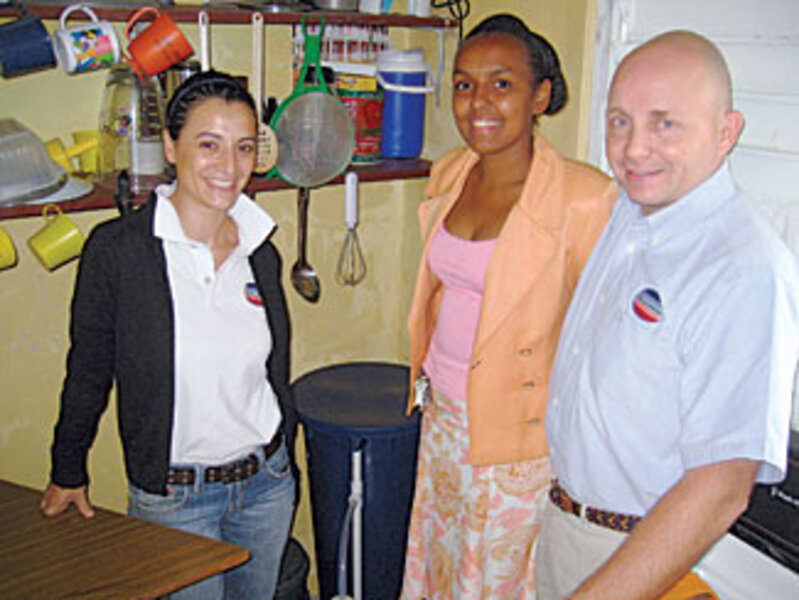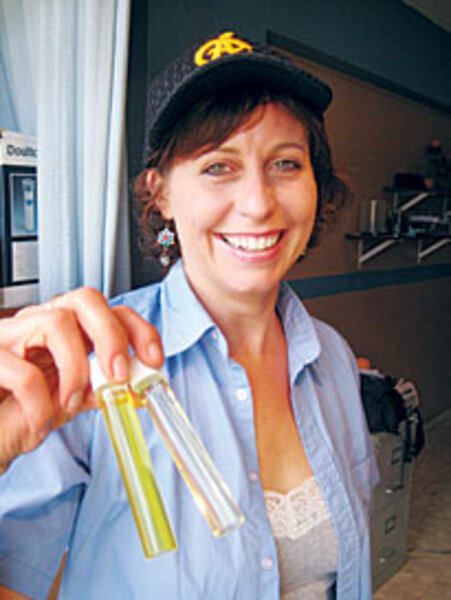People Making a Difference: Bob Hildreth and Lisa Ballantine
Loading...
| Puerto Plata, Dominican Republic
In 1991, Bob Hildreth drilled a well for his new home here. Not long after, people lined up at the spigot alongside his house. Potable water, he’d discovered, was in short supply.
Eighteen years later – the longest time this former US Army aviator has spent in any one place – Mr. Hildreth devotes half his time to his jewelry business, Joyería las Americas, and the other half getting durable, low-tech water filters into the island's barrios.
Worldwide, at least 1.1 billion people don't have access to safe drinking water, according to the World Health Organization, and 2.4 billion lack basic sanitation. Some 1.8 million people die each year from diarrhea, which has been tied to unsafe drinking water – the majority of them children in developing countries.
Given that these losses are preventable, potable water doesn't seem to get the attention it deserves, says Mark Sobsey, professor of environmental sciences at the University of North Carolina at Chapel Hill. "Priorities are higher for other development activities than this," he says. "Sanitation, especially, is not very sexy."
Even piped-in water isn't necessarily safe, Hildreth says. In the developed world, constant water pressure keeps whatever's lurking outside the pipes at bay. In the developing world, however, where power outages are common, water pressure drops and at times even reverses, sucking in raw sewage that's often outside. When the system begins pumping again, it's delivering contaminated water.
"Point-of-use water treatment needs to be adopted by all the developing countries in the world," Hildreth says.
Funded principally by Rotary clubs, his organization – Project las Americas – has delivered 19,000 BioSand filters. One $50 filter cleans 120 gallons of water daily and lasts for decades. In studies, Dr. Sobsey has found that BioSand filters can reduce diarrhea by 47 percent. "You're almost certainly reducing mortality," he says.
Developed in the 1990s by Dr. David Manz, then at the University of Calgary in Alberta, BioSand filters use sand and the bacteria that grow on it to filter water. Users pour water through a diffuser into a gently tapering, belly-high container. (A traditional container made from cement weighs 250 lbs., but a new plastic container weighs just 10 lbs.)
Water passes through 20 inches of sand that comes directly from a quarry. The sand's tiny cracks and chambers filter out microbes. A layer of "good" bacteria forms at the sand's surface. This living film feeds on and removes viruses, bacteria, and parasites. "The technology is so robust that you can screw it up, and it will still keep functioning," Hildreth says.
Two hours inland, in the town of Jarabacoa (pop. 70,000), Lisa Ballantine works on the same problem using a slightly different tool: a ceramic pot filter. Smaller and lighter than the BioSand filter, hers fits into a five-gallon bucket. Pour water into the U-shaped receptacle, and it percolates through porous clay at a rate of two to three quarts per hour. Filters cost $30 to sponsor; Dominicans can buy them directly for $25. "The thing I like about [the] water [problem] is that we can solve it," she says.
Originally from the Chicago area, Ms. Ballantine came to Jarabacoa as a missionary in 2000. After seeing the poverty surrounding her, she wanted to provide practical help. So after her mission was over, she studied ceramics at Northern Illinois University and, in 2006, she returned with her ceramic pot filter idea.
The basic design is nearly two centuries old. Some 170 years ago, amid concerns about cholera, Queen Victoria asked London's Royal Doulton china company to design a water filter. Versions of its design are now used in places such as Cambodia and Honduras.
With help from Manny Hernandez, her ceramics mentor at Northern Illinois, Ballantine has improved on the design, she says. Ceramic filters typically are coated with silver particles. The silver's ionic charge kills microbes on contact. But rather than painting the silver onto the pot, Ballantine mixes it – along with fine sawdust no greater than 1/50th of a human hair in diameter – directly into the clay. The sawdust burns off, leaving minuscule silver-coated chambers. Microbes passing through come into more contact with the silver, and the filter has a much longer life – about five years, she says.
With her partner, Tracy Hawkins, who works in Tanzania, she's founded Filter Pure. Lifelong potter Radhamés Carela from nearby Moca runs her factory. Their goal: Create a model for making high-quality filters with low-tech equipment that's exportable anywhere. At full capacity, the factory can produce 1,000 filter per month. So far, she's given out more than 11,000 filters in the Dominican Republic.
On a sunny March day, Ballantine drives her pickup truck into a muddy, flood-prone neighborhood called "la joya de Jarabacoa." Today, she's giving out filters donated by a church in Streamwood, Ill. A jostling crowd of children forms around the truck. Adults emerge from hammered-together shacks to ask for them.
Typically, residents here buy water from passing trucks that sell it in large plastic jugs. The quality of that water can vary greatly.
But with monthly incomes here averaging about $200, buying a $25 filter can still seem too expensive. Resident Estamilado Durán estimates that of the 300 families in the neighborhood, perhaps five or 10 could afford it.
Ballantine is undeterred. The filter may seem expensive, she tells them in Spanish, but if they account for what they spend on bottled water now – $171 per year per family, she estimates – the savings are readily apparent.
By comparison, using a filter would cost a family less than 2 cents per day, she says.r






